Whether you’re selling doodads on EBay or property via a real estate listing website like LotNetwork.com, it’s well known that photos will dramatically increase your ability to both connect with a buyer faster and attract a higher price. And with real estate, pictures not only are worth more than a thousand words…for a Seller they can be worth thousands of dollars. Yet it is amazing how many people that desperately want to sell a property do not include any photographs in their online listings. Zero. These blank property listings fail to get the attention of buyers, delay a sale and ultimately can cause a seller to lose money.
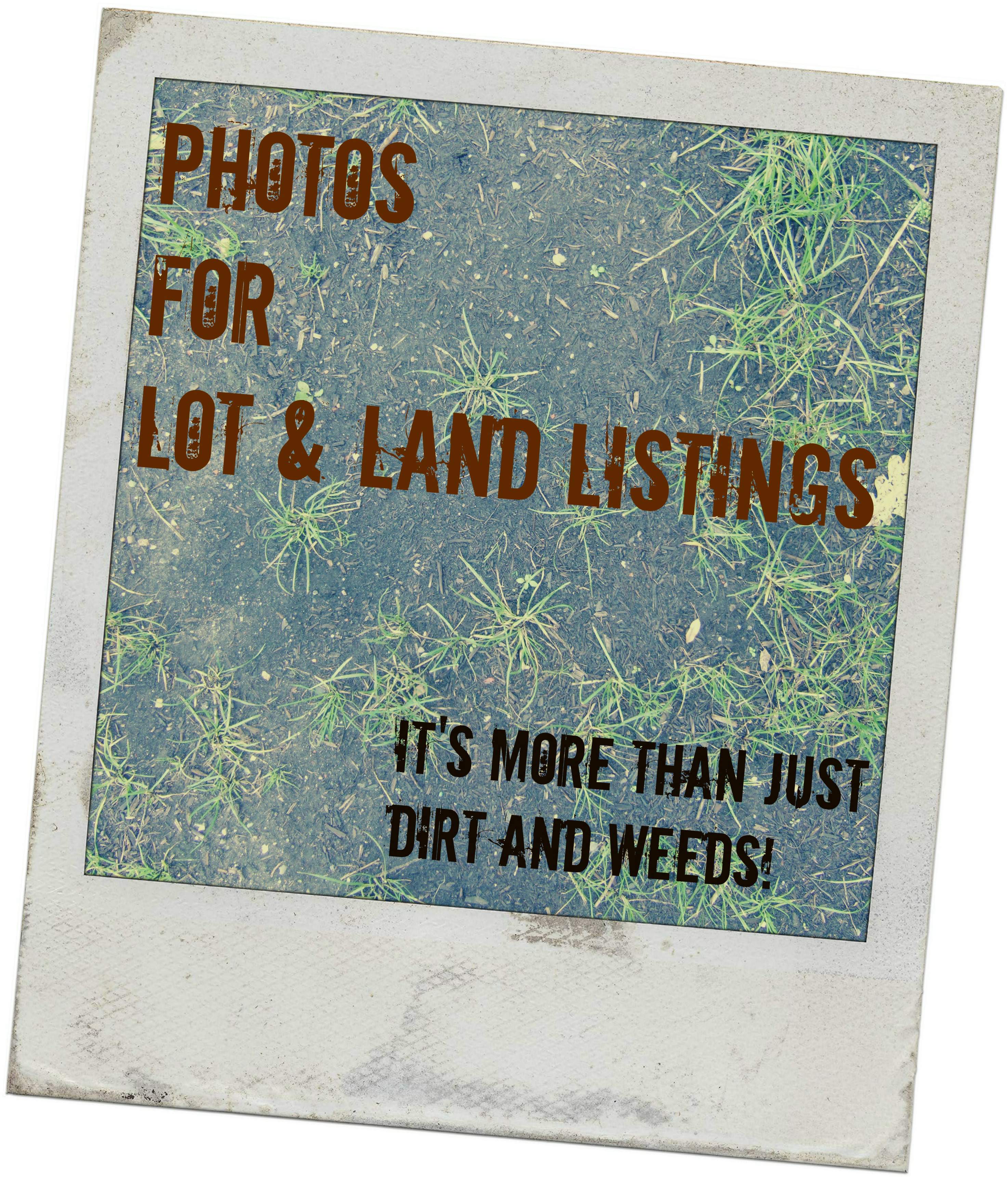
You may ask “But do I really need photos of my vacant lot or land, especially if it’s just some dirt, weeds and trees?” Absolutely! We understand that it can be harder to take good photos of vacant land, but research has shown that including quality photographs in your online listings will help your real estate listing be viewed by more buyers…and not using photos at all is just asking to have your listing be overlooked. In fact, compared to listings with just one photo, listings with many photos attracted more than triple the number of detailed views and more than double the number of leads. And when compared to real estate listings with zero photos, listings that included enough photos were viewed multiples of 55 times more and produced 898 times the number of leads. That’s compelling.
So in this article we describe the types of property photos you should use when marketing lot and land properties. In a second article, we give some helpful tips and tricks for creating great photographs for any lot or land listing…even if you don’t have photos of your property. With this advice, there’s no excuse for having listings without photographs.
What Photos & Images Should I Use to Sell Lots and Land?
Although you could say that almost any image is better than no photo at all, using high quality images of a property’s best features is the goal of expert real estate marketers.
Remember that a real estate listing basically is a marketing flyer for your property, so you want to show your property in its best light and focus on its benefits.
When you’re preparing a listing to sell a house it’s pretty obvious that you will want to include photographs of the home’s lovely front facade, that gorgeous kitchen with granite countertops and its luxurious Master Bedroom suite.
Vacant land can be trickier. And although undeveloped land often includes beautiful, photogenic landscapes and views, what photos can you use of a single vacant lot or relatively barren plot of land?
The Best Types of Images for Lot & Land Listings
There are certain types of photographs that work very well for communicating the features of lot and land listings to potential buyers. And because there are no kitchens or great rooms to show, you sometimes need to be more creative when you are marketing vacant lots and land.
While you may not be able to include all of the following types of photographs in every listing, to help your lot and land listings be most effective we suggest that your photographs:
1. Emphasize Natural Features
There is no home to use as a focal point, so your on-the-ground photos of the property should emphasize its best natural features, like trees, water elements and open space. All buyers — even in urban areas — like to know that they will have trees and greenery surrounding them. But an open lot does not provide visual scale or focal points, so neighbors’ houses may appear to be closer than they really are and streets in the foreground may attract the viewer’s focus. Instead, use appropriate angles and perspectives to limit the view of nearby buildings and pavement that may be both unappealing and distracting to land buyers. Try to use photos from the season that best shows the property — if your client engages you in the dead of Winter, ask them for Spring or Fall photos — and update your photos if conditions improve.
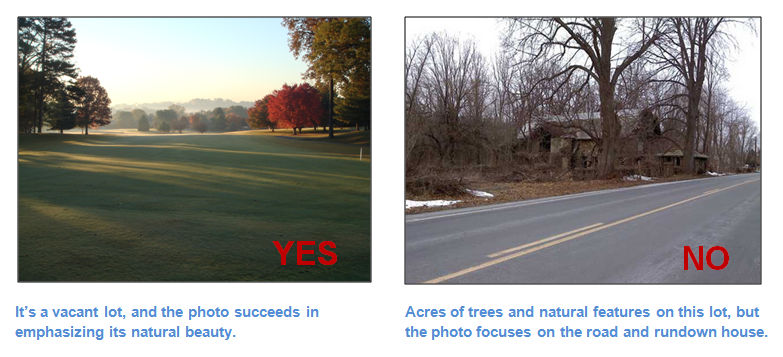
2. Showcase The View
If you have a view from your property, show it! Whether it’s the city skyline, snow-capped mountains or even just a pretty wooded area, a view is a valuable feature and should be shown. It does not matter if the mountain is not actually located on the property. See a great example of creating a “view” from an existing photo in this related article.
3. Highlight Neighborhood Features and Amenities

You not only are selling your property, but also the lifestyle. Show buyers images of the amazing clubhouse or community pool, as well as the nearby lake or park. Does your neighborhood have a well-designed entrance? Then show an image of the entrance monument and landscaping to potential buyers. Can you walk to a historic shopping village? Then show an attractive photo of the nearby shops too.
4. Show Aerial Images of the Site
Aerial photos are one of the most important types of images you can use to visually describe a vacant lot or land parcel. On-the-ground photos are valuable, but an aerial image can show buyers a bird’s eye view of things that you can’t otherwise see at eye-level.
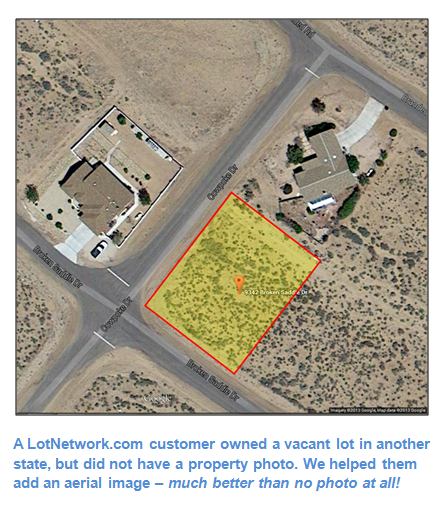
With an aerial photo you can best explain the layout of the site and its property lines. And when it’s to your advantage, aerials are very important for showing the proximity of nearby buildings, homes, street frontage, wooded buffers and more. These just can’t be seen in the same way with a ground-level shot. You even can include multiple aerial views so that you show a close up of the site plus the location of the site in the neighborhood (read about area maps below). And best of all, thanks to satellite imagery and Internet mapping technology anyone can include a nice aerial image of their property at no cost with just a few minutes of work on their computer. Our related article gives great tips on using screenshots to add photos to your lot and land listings.
5. Include Surveys or Site Plans
A survey or site plan is very important when selling lots and land, and is another helpful visual tool that you should include. Much like aerial photos, a survey of the site can show a buyer things that they can’t learn any other way. Accurate site dimensions, property lines, setbacks, easements and other important features all may be accurately gleaned from a professional survey or site plan and are valuable information for buyers. Surveys and site plans are critical to include when you are marketing your property to homebuilders and developers.
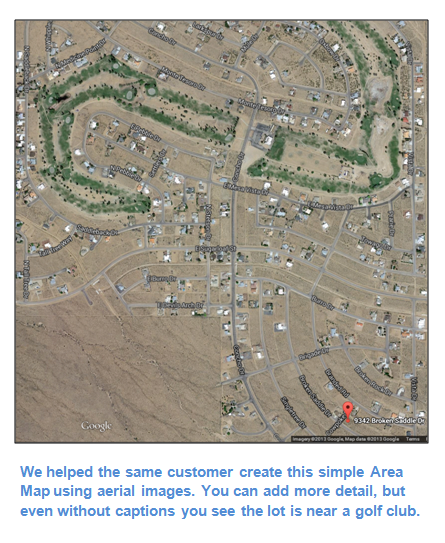
6. Describe With Area Maps
Although not entirely necessary, sometimes it is helpful for you to upload either an overview map for the neighborhood or an area map that you have prepared specifically for your listing.
LotNetwork.com includes an automated satellite map in every listing, so buyers are able to see a mapped location of your site without you doing any additional work (other than making sure that you provide an accurate address that can be mapped, or that you manually identify the property’s location using LotNetwork.com’s Interactive Map & Confirm Tool when adding or editing your listing). Some sellers may want to include a fixed image of an area map so that they can pinpoint nearby amenities and really showcase the property’s location.
7. Advertise Your Proposed Home Elevations & Plans

Last but not least, if you are a builder selling a Turnkey Listing you may want to include proposed new home elevations and floor plans in your lot listing. These days many new homebuyers look for a location first. Turnkey Listings are a LotNetwork.com feature that lets builders market their lots to homebuyers and offer to build a turnkey home for the buyer on that lot. Turnkey Listings connect homebuyers with homebuilders. Buyers are happy because they choose their lot as the location for their new home, and then work with the homebuilder to choose a houseplan and options that meet their specific needs and desires. Builders are happy because they connect with more buyers, sell homes before even breaking ground…and because they have happy customers.
Selecting & Organizing Your Images To Help You Sell
Now that you have photographs of your property, make sure you prepare and select the best images to help you sell. This process doesn’t take much time, but it’s worth it.
Use Quality Photos That Focus on the Property’s Best Features
A good photograph is one of the primary tools you can use to grab a buyer’s attention and make a great first impression. If you lead with poor quality photos or highlight unattractive features on the property, you are likely to lose the buyer before your listing ever has a chance to help you sell your property.
Many recommend that you use a professional photographer who can help you present your property’s best features in a beautiful way. If feasible, professional photos can help you sell more quickly and often pay for themselves in the sales price. But depending on the economics, and the particular property, this option may not make sense for every seller and every listing.
Here are just a few basic tips to make sure the photographs and images you select do their best to help you sell your property:
- Use your photographs that show the best features. Avoid images with unattractive views or negative visual distractions.
- Do not use blurry or out-of-focus photos in your listings. Use an adequate level of resolution so that the image is clear when viewed online.
- Your photographs should show well-maintained areas, with no debris or trash visible.
- Even if you must use a mobile phone or point-and-shoot camera, you still can take photos that are high quality images.
- Review your listing after you have uploaded your photos to make sure you love the way everything looks.
In addition to these photo tips for your listings and the photography tips in our related article, we have many other resources that can help you when you are preparing your lot or land for sale. Read our articles about 5 Tips to help you sell with online listings and how to sell lots and land (and why it’s different from selling homes).
When preparing your listing you should be sure to use your best photographs, and also avoid the urge to include a photograph of something “Because it’s there” or to add too many unnecessary photographs “Because I have them.”
Avoid The Shack: I took the photograph “because it was there”
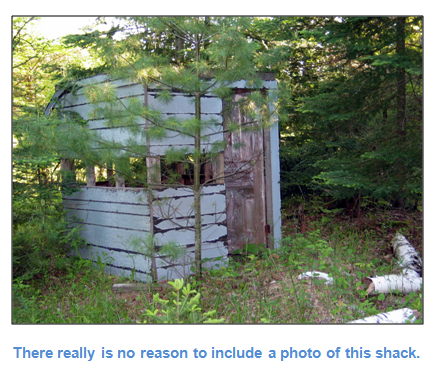
Too many listings for vacant property include photos of dilapidated shacks, old sheds, vacant homes or broken fences. It seems that when people go to a property with a camera, they often feel the need to take photographs of every structure or feature on the property…basically “because it’s there.” We encourage you to try to focus on attractive natural features and open space as noted above.
Instead of helping you sell, these shacks and old structures can convey negative messages to potential buyers – and make them wonder how much it would cost to demolish. Step back, look at the photos and ask yourself: Does this photograph show the property well? Could a potential buyer be turned off by this image? Exclude any images that don’t pass these tests.
Avoid Tree 1, Tree 2, Tree 3: I included the photographs “because I have them”
You always should make sure a photograph is adding value before uploading it to your online listing. You do not have to show photos of everything on the property, and you don’t need to include a photo just because you have it on your computer or camera.
While you can add an unlimited number of photos to your listings on LotNetwork.com, it’s wise to avoid overloading the listing with a bunch of unimpressive or distracting photos of this tree, that tree and another tree, etc. Find the best photo (or few photos) of each feature on the property. Don’t just show the same types of features – like trees, or the barren ground – many times.
Make sure the buyer sees your best images. Avoid losing a buyer’s interest by adding a lot of similar shots that don’t add value.
How Many Photos & Images Should I Include?
There is research related to selling homes that suggests that the listings with more photographs sell faster and at a better price. We believe this generally is true with lot and land listings too, but with a few caveats. For selling homes, the research basically suggested that listings should include as many photos as possible. But unlike a finished house, there often are not as many unique looking features to photograph on vacant land. We think it’s possible that using too many photos in a lot or land listing can produce negative results. As noted above, you always should make sure that your images focus on the best features of the site and your most important selling messages.
If possible, we recommend that you try to include up to about 7-8 of the best on-the-ground images of your property or the neighborhood. This gives a potential buyer enough to both catch their attention and provide useful information. Add to that any additional aerial images, surveys, Turnkey Listing elevations and other information that will be helpful. If you believe you have more photos that truly add value, then certainly add them too.
Your Main Photo: The Importance of First Impressions
Choose the best shot to be your “Main” photo that appears in search results and is the initial photo when the details are viewed. Lead with your strengths. It’s important for first impressions. So showcase that great view, neighborhood feature or an aerial image as your Main image if the lot just isn’t that photogenic.

In our related article we show you how to easily use satellite maps and other online tools for images that dramatically improve your lot and land listings. Learn how to crop your existing photos so they are more effective and use screenshots to include aerial photographs, all without even leaving your computer. Your listings will look great and have a better chance of helping you sell.
Related Articles:
- Tips on Using Screenshots & Cropping for Better Property Photos — lotnetwork.com
- How to Sell Lots and Land (and Why it’s Different from Selling Homes) — lotnetwork.com
- Online Listings to Sell Lots or Land: Five Tips to Help Spur a Successful Sale — lotnetwork.com
- Sell Land, Development Projects & Portfolios of Residential Lots with “Project Listings” – lotNetwork.com
- Reach More Lot & Land Buyers: Upgrade Your MLS Listings On LotNetwork.com – LotNetwork.com
For more helpful tools and ideas, see our dedicated page on Resources and Tips for Selling Lots & Land.
And if you are a Real Estate Pro, check out our Resources for Real Estate Agents & Brokers or our Resources for Builders & Developers to learn more about LotNetwork.com’s features and benefits that can help both you and your business.

